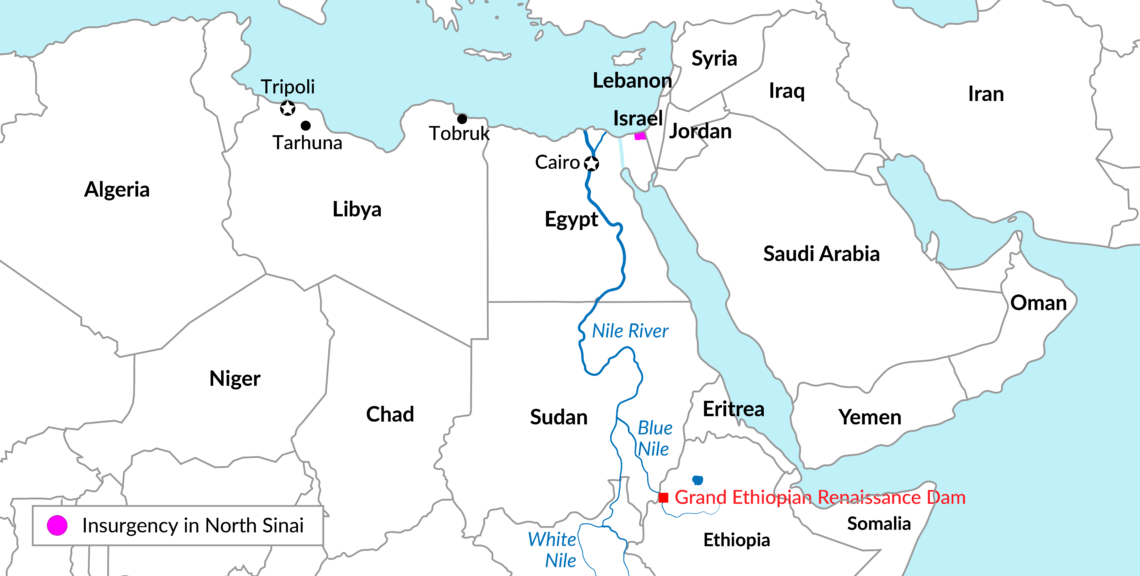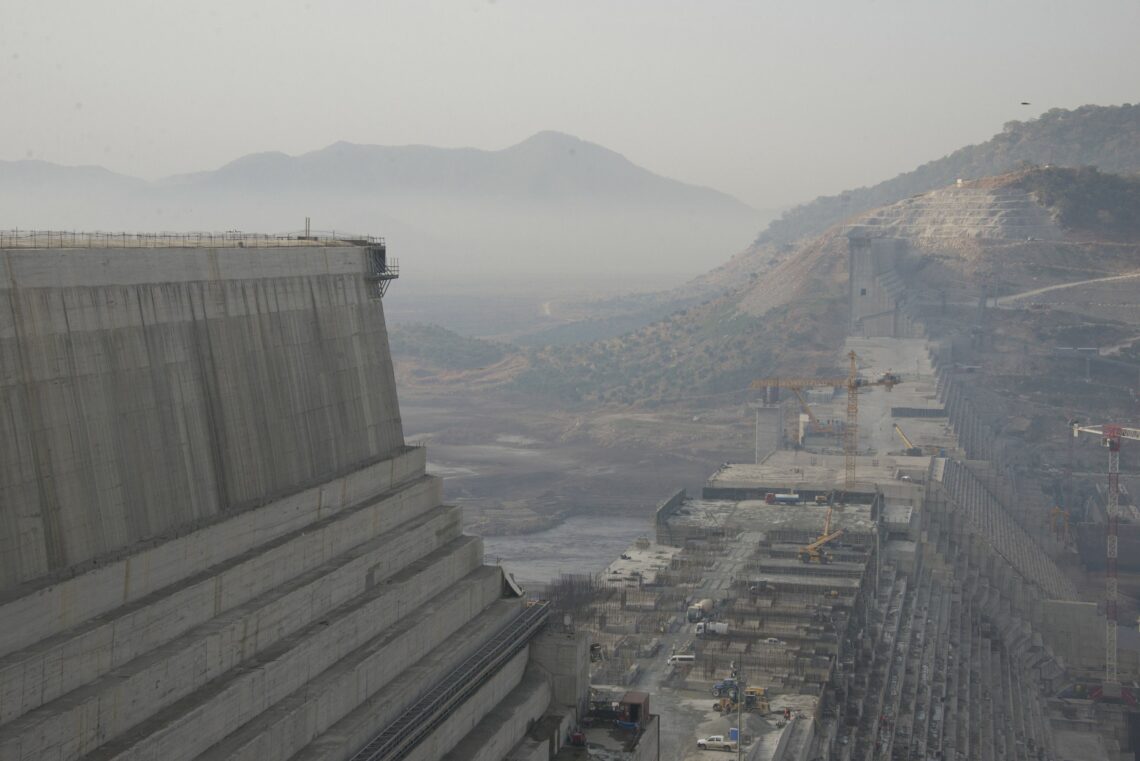Looking for compromise on Ethiopia’s Renaissance Dam
Egypt, Ethiopia and Sudan are struggling to strike a deal over the Grand Ethiopian Renaissance Dam. Although the dam would triple the electricity production and generate economic growth, it would impede economic and political interest of Egypt. If the parties can’t reach an agreement in the U.S.-led process, Russia and China may step in.

In a nutshell
- Ethiopia’s GERD will be the biggest dam in Africa
- Tensions are rising with key Nile countries Egypt and Sudan
- The U.S. are leading a negotiation process
- If American efforts fail, Russia or China may step in
This October saw another fruitless meeting between the Egyptian minister for water resources and irrigation, the Ethiopian minister of water, irrigation and energy, and the Sudanese minister of water resources. The subject was the ongoing construction of the Grand Ethiopian Renaissance Dam (GERD), due to be completed in 2020, and the conditions under which it will be filled and operated. The lack of results led Egypt to call on the United States to help find a last-ditch compromise, which was immediately accepted. Both Egypt and Ethiopia are America’s strategic allies in a highly sensitive region, and a conflict between them would threaten the stability of East Africa and the Red Sea.
Grand ambitions
Work on the GERD started in 2011. The purpose of the dam is allegedly to produce electricity at the exclusion of water for irrigation and domestic consumption, so as not to further reduce downriver flow. It will be the largest dam in Africa and is expected to yield 6450 megawatts, tripling Ethiopia’s production and bringing electricity to the 65 percent of the country’s population that is still without it. Surpluses would be exported to neighboring countries, generating income for urgent economic development as the population passes the 110 million mark.
To deflect the expected condemnations, Ethiopia proclaimed that building the dam was its sovereign right. The government set up a local utilities company to direct and supervise the $4.8 billion megaproject, which it will fund in its entirety. Turbines and other equipment, valued at $1.8 billion, will be provided by China and financed through Chinese banks at a preferential rate. The Italian firm Salini Costruttori has been entrusted with the construction (expected to cost $3 billion) at the direction of the Ethiopian utilities company. The lack of experience of that company, confronted by such a huge and complex task, has led to repeated setbacks and delays; the first Ethiopian site manager even committed suicide in 2018. Today, 69 percent of the dam has been completed, according to Ethiopian reports, and it should be operational toward the end of 2020 (three years after the original deadline).
The GERD is situated on the Blue Nile, which flows from Lake Tana in Ethiopia and supplies 80 to 85 percent of Nile waters. It is joined south of Khartoum, in Sudan, by the White Nile, which begins at Lake Victoria in Uganda and Tanzania. Together the two flow into Egypt, bringing water and alluvions to its desert soils. North of Cairo the Nile divides itself into two branches, which, on their way to the Mediterranean, form the rich, agricultural Delta region.
Competing interests
Egypt is the gift of the Nile, wrote Greek historian Herodotus in the fourth century B.C. The country’s dependence on the river has barely abated since then, and it has remained focused on agriculture, which now accounts for 12 percent of its GDP and 20 percent of its workforce. Altogether, the Nile provides for 90 percent of the country’s agricultural needs and domestic consumption. If the reservoir behind the Ethiopian dam is filled too quickly, there are fears that it would significantly lower the river’s annual 85 billion cubic meter flow and adversely affect the quota of water attributed to Egypt in a 1959 treaty, which amended the original 1929 agreement dictated by Great Britain: 55.5 billion cubic meters, with 18.5 for Sudan and barely 13 percent to other Nile basin countries.
Egypt has launched an all-out effort against the GERD project on the basis of its historic treaty rights.
In accordance with previous treaties, Cairo would also keep supervising the flow of the Nile and have a veto over the construction of dams and other water installations in Nile basin countries: Ethiopia, Sudan, South Sudan, Tanzania, Uganda, Burundi, Rwanda, Kenya, and the Democratic Republic of Congo. A team of Egyptian experts is stationed north of Lake Victoria in Uganda to monitor the flow of water and how it is used in neighboring countries. It must be remembered that quotas and other dispositions were attributed in 1929, at a time when Great Britain was a colonial power ruling Egypt and Sudan.
Egypt has launched an all-out effort against the GERD project on the basis of its historic rights enshrined in the aforementioned agreements. Even before construction began, Cairo called on the World Bank and other international institutions (in vain) not to finance the dam or participate in its construction. Ethiopia stood on its sovereign rights, arguing that treatises made under colonial rule were no longer valid. Work continued and is due to be completed next year. Can Ethiopia and Egypt reach a compromise within that short timeframe?
Changing landscape
The writing was on the wall for decades, but Egypt refused to acknowledge the rapid changes occurring in East Africa following the decolonization process of the 1960s. Population growth and ensuing development efforts in Nile Basin countries led them to clamor for larger water quotas. In 2010, these countries decided on a new cooperation agreement and a new repartition of Nile waters to address their own needs; some of them even appear to be, diverting part of the flow for their own development.
Cooperation between all parties, with the help of international institutions such as the World Bank, could have increased the Nile flow. Upper Nile countries are blessed with bountiful rainfalls estimated at 1.6 trillion cubic meters per year, but barely 85 billion reach the river; of the waters that do, a large part is lost to evaporation and the formation of swamps and algae proliferation slowing the flow. The introduction of drainage canals channeling rainfall toward the river and the elimination of vegetation along the banks would have obviated some of those obstacles. The proposed Jonglei Canal in South Sudan, which would have diverted the river to avoid a vast swamp area where billions of cubic meters of water are lost, was abandoned following the civil war there.

Though most of the countries concerned have other sources of water, such as abundant rainfall or smaller rivers, Egypt (with its 96 percent desertic areas) is wholly dependent on the Nile. A significant decrease in the Nile flow would impact agriculture, notably thirsty crops such as cotton, a main source of income for millions of Egyptians as well as export revenues. According to recent studies, it would also lead to food and water shortages and mass migration of farmers to the already overcrowded capital. River navigation, the main means of transport in Egypt, could also be affected if water depth decreases. In 2018, fewer rains in the Nile Basin caused riverboats bringing tourists from Luxor to Aswan to run aground. Yet much-needed water management through recycling and desalination plants has not been implemented.
Egypt started negotiations with Ethiopia only in 2013, when it became aware of a temporary diversion of the river to allow for the construction of the dam. The news took Cairo by surprise. For years, it had considered the Nile as its property, grudgingly letting Sudan have its share because it had been long under its rule and was seen as a sister state. In the early stages, there were calls to forcibly destroy the dam. President Abdel-Fattah El-Sisi declared that Egypt would use all necessary means to preserve its rights on the Nile waters.
Looking for a deal
Nevertheless, both countries understood that a compromise answering their needs had to be found. Countless meetings between the relevant ministers were held, and committees were tasked to formulate solutions. Sudan reluctantly joined the negotiations because of the treaties binding it to Egypt. It is not solely dependent on the Nile because of its abundant rains, and even considered that, properly administered, the Ethiopian dam could prevent annual seasonal flooding.
Leaders of the three countries met several times, most recently at the end of October in Sochi at a summit of African and Russian leaders – but all to no avail. As new rumors of a possible Egyptian military intervention circulated, the Ethiopian Prime Minister Abiy Ahmed grandly declared that nothing would stop Ethiopia from building the dam, and that it would muster millions of its citizens to defend it. That declaration cast a pall over his meeting with President El-Sisi in Sochi.
Meanwhile, according to other rumors, Israeli anti-missile systems were set to be to be already deployed around the dam. Israel, which cooperates with both Egypt and Ethiopia in a number of areas, firmly denied selling the anti-missile systems. A confrontation between the countries would endanger the whole region.
The main stumbling block at this stage appears to be the length of the period during which the reservoir will be filled. Addis Ababa wants the dam to be fully operational as soon as possible and intends to fill the reservoir over the course of six rain seasons. Egypt wants a minimum of ten seasons, to avoid the catastrophic consequences discussed above. There is room for compromise here; however, Cairo demands to participate in the operation of the dam to ensure it will keep getting the water resources it needs. It fears that, in drought years, upper Nile countries will take out more water from the river and reduce its own share, and that the dam could weaken the strength of the flow and allow salted seawater to penetrate the river upstream. This phenomenon already occurred after the construction of the Aswan Dam in Egypt, and is expected to become more acute with the new dam. Egypt cannot afford to lose control and become dependent on the goodwill of the upper Nile countries.
Failure to find a compromise could lead to a violent confrontation that both countries are keen to avoid.
Real fears and a mutual lack of trust, resulting in five years of barren negotiations, convinced Egypt to turn to the U.S. The Egyptians hope American influence can help implement the resolution adopted in Khartoum in 2015, calling for a solution answering the needs of both sides, with the option to ask for third-party mediation in case of failure. Ethiopia, which had consistently refused to address the very real concerns of Egypt, reluctantly agreed to the mediation.
Washington acted promptly, inviting the foreign ministers of Egypt, Ethiopia and Sudan to present their case to the U.S. Congress and other expert groups. There was a photo-op in the White House with President Donald Trump, who decided that negotiations would go on not on the political level between foreign ministers, but in technical meetings between ministers in charge of water supply under the auspices of U.S. finance minister Steven Mnuchin.
Following the first meeting, held with the participation of David Malpass, the president of the World Bank, the ministers reiterated their commitment to reach an agreement, and to permanent cooperation over meeting needs on filling and operating the dam and setting up a mode of supervision, as had been agreed in the 2015 declaration. Four meetings were to be held in the presence of representatives of the U.S. and the World Bank, in order to reach an agreement before January 15, 2020. Two meetings with Mr. Mnuchin were also scheduled to evaluate progress.
The first meeting was held In Addis Ababa on November 15, with the three water ministers cautiously optimistic despite major differences of opinion. At the second meeting, held behind closed doors in Cairo from December 2-3, no breakthrough was achieved either. The third one will take place in Khartoum at the end of December, and the fourth in Addis Ababa at the beginning of January.
Scenarios
Can a peaceful resolution be achieved in less than two months? With Washington exerting its considerable influence on Cairo and Addis Ababa, the odds are slightly better. Still, what is needed is not only compromise but cooperation, with a suitable process of control over the provisions of the agreement: Egypt’s involvement in the filling of the reservoir, the dam’s operation during drought years, and the production of electricity, rather than water for agriculture or domestic consumption.
Any lesser compromise could not be accepted by Cairo without provoking a public outcry, threatening the stability of the regime. No compromise at all, in turn, could lead to a violent confrontation that both countries are keen to avoid. Egypt might then be hard put to avoid a military operation – presumably the bombing of the dam – far from its own borders while still battling Islamic insurgency in Sinai, a costly operation at a time when President El-Sisi needs all his country’s resources to address the economy.
Ethiopian Prime Minister Ahmed, who was recently awarded the Nobel Peace Prize, shows no sign of bending. But it is obvious that any compromise will entail some concessions – and that causing instability in Egypt would not be in the interest of his country, either.
If America fails to step in forcefully, other great powers might be tempted to act, especially Russia and China. The former strives to expand its influence in Africa, and the latter already has solid economic interests in the continent. Their involvement, however unlikely it may seem at the present, would deal a major blow to U.S. prestige and its role not only in Africa, but in the whole Middle East.








